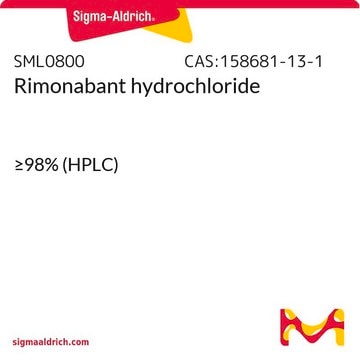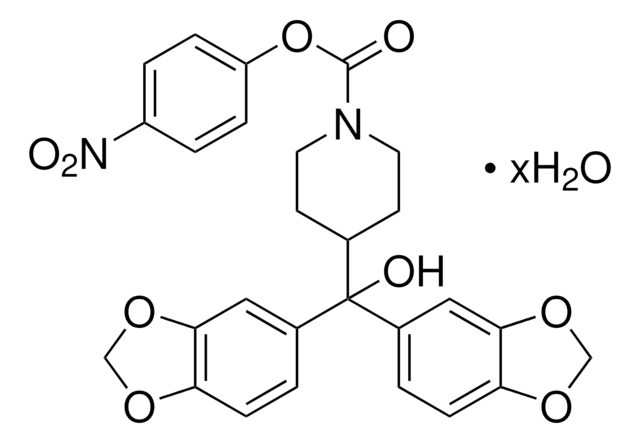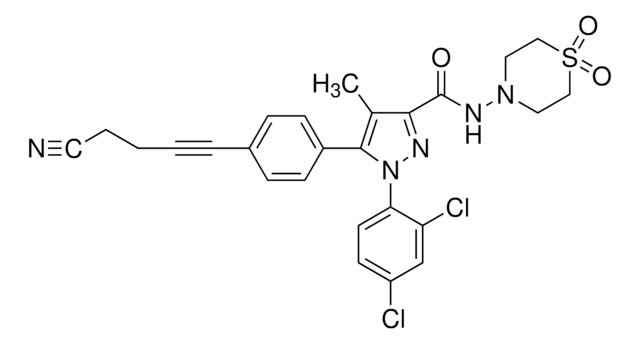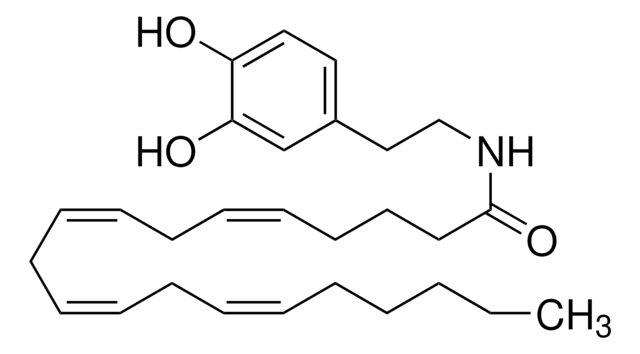A6226
AM251
>98% (HPLC), solid, cannabinoid receptor (CB1) antagonist
Sinónimos:
1-(2,4-Dichlorophenyl)-5-(4-iodophenyl)-4-methyl-N-1-piperidinyl-1H-pyrazole-3-carboxamide
About This Item
Productos recomendados
Nombre del producto
AM251, >98% (HPLC), solid
Nivel de calidad
Ensayo
>98% (HPLC)
Formulario
solid
color
white
solubilidad
DMSO: >10 mg/mL
H2O: insoluble
emisor
Sanofi Aventis
cadena SMILES
Cc1c(nn(-c2ccc(Cl)cc2Cl)c1-c3ccc(I)cc3)C(=O)NN4CCCCC4
InChI
1S/C22H21Cl2IN4O/c1-14-20(22(30)27-28-11-3-2-4-12-28)26-29(19-10-7-16(23)13-18(19)24)21(14)15-5-8-17(25)9-6-15/h5-10,13H,2-4,11-12H2,1H3,(H,27,30)
Clave InChI
BUZAJRPLUGXRAB-UHFFFAOYSA-N
Información sobre el gen
mouse ... Cnr1(12801) , Cnr2(12802)
rat ... Cnr1(25248)
Aplicación
Acciones bioquímicas o fisiológicas
Características y beneficios
Otras notas
Frases de peligro
Consejos de prudencia
Clasificaciones de peligro
Aquatic Chronic 4
Código de clase de almacenamiento
11 - Combustible Solids
Clase de riesgo para el agua (WGK)
WGK 3
Punto de inflamabilidad (°F)
Not applicable
Punto de inflamabilidad (°C)
Not applicable
Equipo de protección personal
dust mask type N95 (US), Eyeshields, Gloves
Elija entre una de las versiones más recientes:
Certificados de análisis (COA)
¿No ve la versión correcta?
Si necesita una versión concreta, puede buscar un certificado específico por el número de lote.
¿Ya tiene este producto?
Encuentre la documentación para los productos que ha comprado recientemente en la Biblioteca de documentos.
Los clientes también vieron
Nuestro equipo de científicos tiene experiencia en todas las áreas de investigación: Ciencias de la vida, Ciencia de los materiales, Síntesis química, Cromatografía, Analítica y muchas otras.
Póngase en contacto con el Servicio técnico













